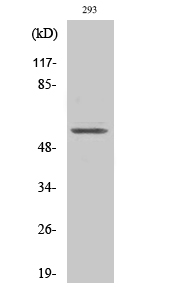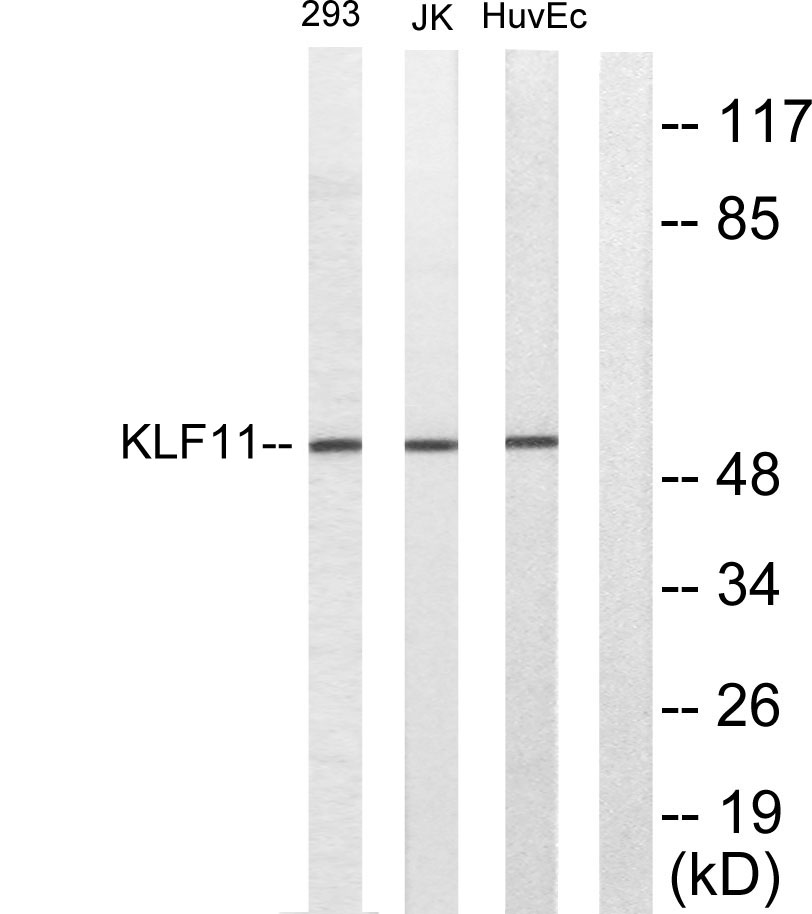TIEG2 Polyclonal Antibody
- Catalog No.:YT4653
- Applications:WB;IHC;IF;ELISA
- Reactivity:Human;Mouse
- Target:
- TIEG2
- Gene Name:
- KLF11
- Protein Name:
- Krueppel-like factor 11
- Human Gene Id:
- 8462
- Human Swiss Prot No:
- O14901
- Mouse Gene Id:
- 194655
- Mouse Swiss Prot No:
- Q8K1S5
- Immunogen:
- The antiserum was produced against synthesized peptide derived from human KLF11. AA range:1-50
- Specificity:
- TIEG2 Polyclonal Antibody detects endogenous levels of TIEG2 protein.
- Formulation:
- Liquid in PBS containing 50% glycerol, 0.5% BSA and 0.02% sodium azide.
- Source:
- Polyclonal, Rabbit,IgG
- Dilution:
- WB 1:500 - 1:2000. IHC 1:100 - 1:300. IF 1:200 - 1:1000. ELISA: 1:20000. Not yet tested in other applications.
- Purification:
- The antibody was affinity-purified from rabbit antiserum by affinity-chromatography using epitope-specific immunogen.
- Concentration:
- 1 mg/ml
- Storage Stability:
- -15°C to -25°C/1 year(Do not lower than -25°C)
- Other Name:
- KLF11;FKLF;TIEG2;Krueppel-like factor 11;Transforming growth factor-beta-inducible early growth response protein 2;TGFB-inducible early growth response protein 2;TIEG-2
- Observed Band(KD):
- 55kD
- Background:
- The protein encoded by this gene is a zinc finger transcription factor that binds to SP1-like sequences in epsilon- and gamma-globin gene promoters. This binding inhibits cell growth and causes apoptosis. Defects in this gene are a cause of maturity-onset diabetes of the young type 7 (MODY7). Three transcript variants encoding two different isoforms have been found for this gene. [provided by RefSeq, Apr 2010],
- Function:
- caution:PubMed:11087666 sequence was originally thought to originate from mouse.,disease:Defects in KLF11 are the cause of maturity-onset diabetes of the young type 7 (MODY7) [MIM:610508]. MODY [MIM:606391] has an autosomal dominant inheritance, onset at age less than 25 years and a primary defect in insulin secretion. MODY pedigrees are usually multigenerational families with penetrance of 80 to 95%. Patients have a nonobese body habitus and the so-called metabolic syndrome characterized by diabetes, insulin resistance, hypertension, and hypertriglyceridemia is absent.,function:Transcription factor. Activates the epsilon- and gamma-globin gene promoters and, to a much lower degree, the beta-globin gene and represses promoters containing SP1-like binding inhibiting cell growth. Represses transcription of SMAD7 which enhances TGF-beta signaling. Induces apoptosis.,induction:By TGF-beta.,s
- Subcellular Location:
- Nucleus .
- Expression:
- Ubiquitous. Higher expression in erythroid cells.
- June 19-2018
- WESTERN IMMUNOBLOTTING PROTOCOL
- June 19-2018
- IMMUNOHISTOCHEMISTRY-PARAFFIN PROTOCOL
- June 19-2018
- IMMUNOFLUORESCENCE PROTOCOL
- September 08-2020
- FLOW-CYTOMEYRT-PROTOCOL
- May 20-2022
- Cell-Based ELISA│解您多样本WB检测之困扰
- July 13-2018
- CELL-BASED-ELISA-PROTOCOL-FOR-ACETYL-PROTEIN
- July 13-2018
- CELL-BASED-ELISA-PROTOCOL-FOR-PHOSPHO-PROTEIN
- July 13-2018
- Antibody-FAQs
- Products Images

- Western Blot analysis of various cells using TIEG2 Polyclonal Antibody cells nucleus extracted by Minute TM Cytoplasmic and Nuclear Fractionation kit (SC-003,Inventbiotech,MN,USA).

- Western blot analysis of lysates from 293, Jurkat, and HUVEC cells, using KLF11 Antibody. The lane on the right is blocked with the synthesized peptide.

- Immunohistochemical analysis of paraffin-embedded human tonsil. 1, Antibody was diluted at 1:200(4° overnight). 2, Tris-EDTA,pH9.0 was used for antigen retrieval. 3,Secondary antibody was diluted at 1:200(room temperature, 45min).


